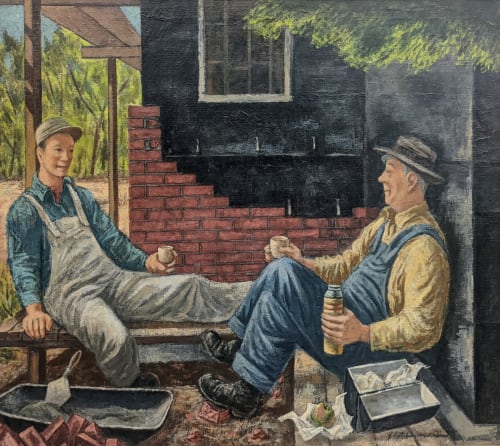When Fletcher Martin died in 1979, the New York Times entitled his obituary “Artist of Action.” No three words better encapsulated Martin’s place in twentieth-century U.S. art. Not since George Bellows had any U.S. artist been so enraptured by rough and rugged masculinity. Martin carved out a name for himself by painting and illustrating men in combat, rodeos, racetracks, boxing matches, and saloons.
Fletcher Martin was born in 1904 in Palisade, Colorado, one of seven children of newspaperman Clinton Martin and his wife Josephine. He acquired a knowledge of the western United States as the family relocated to Idaho and Washington. Martin dropped out of high school at age 15 and was largely self-taught as an artist. He took on a series of odd jobs--migratory farmworker, light heavyweight boxer, lumberjack, and printer—that would later provide the subjects for some of his most evocative work. After serving in the Navy (1922-26), Martin settled in Los Angeles.
Working for the Federal Art Project of the Works Progress Administration enabled Martin to quit his job as a printer in 1935 and try a career in painting. He won several commissions to paint murals in the naturalistic American Scene style including one in Los Angeles and one in Kellogg, Idaho. Much of his work from this time reflected labor issues, often taking a pro-worker stance. Martin was active in the L.A. chapter of the anti-fascist American Artists Congress, serving as president in 1939. In 1938, the Museum of Modern Art bought his “Trouble in Frisco,” a porthole view of a striking longshoreman and a strikebreaker.
During World War II, Martin worked as an artist-correspondent for Life Magazine and made hundreds of sketches of U.S. soldier life. The 27 December 1943 issue of Life magazine featured 14 of his painting from the North African campaign, including the cover illustration. The feature helped to bring him national recognition. He subsequently made illustrations of wartime London and the 1944 Allied invasion of France.
In the 1950s, with the American Scene in eclipse, Martin dabbled in landscapes, abstractionism, and even ‘naïve’ images of women and children. Despite this slight turn to more decorative work, he still loved to paint manly sports, the more violent and dangerous, the better. Boxers remained a favorite subject, but cowboys and bullfighters also put in an appearance. Many of Martin’s most popular works were reproduced as woodcuts, lithographs, or silkscreens and appeared in countless taverns, restaurants, and basements across the United States.
Martin’s restlessness was legendary. After World War II, he settled in New York City in 1945 and then in Woodstock, NY. However, he traveled widely as a teacher and illustrator, usually remaining no more than a year or two at schools around the United States. Martin married five times as well as a famous relationship with movie star Sylvia Sidney; four of his marriages ended in divorce. At his death from a heart attack at 75 years of age, he was dividing his time between Mexico and a home in Sarasota, Florida.
Fletcher Martin remains well known for his images of soldiers in World War II and his depiction of boxing matches. Yet despite the violence inherent in his favorite subjects, he was able to depict the soldier, the worker, the sportsman or the everyday man with both strength and empathy.



